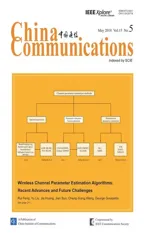NETWORK-CONNECTED UAV COMMUNICATIONS
2018-03-21YongZeng,ShiJin,QihuiWu等
Unmanned aerial vehicles (UAVs) have found fast growing applications in recent years, such as for cargo delivery, precision agriculture, aerial monitoring,video streaming, traffic control, rescue and search, and communication relaying. As the number of UAVs and their related applications grow explosively in the coming years, it is imperative to develop high-performance wireless communication technologies, not only for supporting the ultra-reliable UAV remote command and control (C&C) to ensure their safe operations, but also for enabling high-capacity mission-related information transmission for rate-demanding applications.
Integrating UAVs into cellular and satellite networks is a promising solution to achieve the above goals, where UAVs with their own missions could be connected with either cellular base stations (BSs) or satellites as special aerial users, referred to as network-connected UAVs.Thanks to the almost ubiquitous accessibility worldwide and advanced authentication mechanisms of cellular and satellite systems, network-connected UAVs are expected to significantly outperform the traditional direct groundto-UAV communications, in terms of reliability, security,throughput, and operation range. Moreover, the integration of UAVs can also be utilized for UAV-assisted communications, where UAVs such as drones, helikites,and balloons, are deployed as dedicated communication platforms to assist the terrestrial communications.UAV-assisted communications have many promising advantages, including the ability for swift and on-demand deployment, high flexibility in network reconfiguration,as well as high chance of having short-distance LoS communication links. Thus, UAV-assisted communications have numerous potential use cases, including wireless connectivity for remote areas, public safety, BS of floading, disaster relief, information dissemination and data collection for Internet of Things (IoT).
To practically realize the promising visions of network-connected UAVs and UAV-assisted communications, many new challenges need to be addressed. In particular, UAV communications are significantly different from the extensively studied terrestrial or satellite communications, due to the high altitude and mobility of UAVs, the unique channel characteristics of UAV-ground and UAV-satellite links, the asymmetric quality of service (QoS) requirements for downlink UAV C&C and uplink mission-related data transmission, the stringent constraints imposed by the size, weight, and power(SWAP) limitations of UAVs, as well as the additional design degrees of freedom with joint UAV mobility control and communication resource allocation.
This Feature Topic Issue on “Network-Connected UAV Communications” has received overwhelming responses with a large number of submissions. All papers have been rigorously peer-reviewed, and the accepted papers will be published in two collections, with the first one consisting of 6 papers.
The first article, “Outage Performance of Non-Orthogonal Multiple Access Based Unmanned Aerial Vehicles Satellite Networks” by Ting Qi, et al., studies a UAV communication system integrated into satellite network. By applying the emerging technology of non-orthogonal multiple access (NOMA), the UAVs are served by satellite using the same spectrum as the ground satellite user, and the outage performance is analyzed by taking into account the rain fading and fading correlations.
The second article, “Outage Probability Minimization for Low-Altitude UAV-Enabled Full-Duplex Mobile Relaying Systems” by Meng Hua, et al., investigates a novel system with a UAV utilized as a flying full-duplex relay to assist the terrestrial communications. The outage probability of the system is minimized via jointly optimizing the source/relay transmit power and the UAV trajectory.
In the third article, “Optimal Deployment Density for Maximum Coverage of Drone Small Cells” by Chao Dong, et al., the authors focus on the drone small cell system by leveraging multiple drones to form small cells in the sky to serve the ground users. By using the probabilistic line of sight (LoS) channel model for the air-toground communication links, the deployment density of the drone small cells is optimized by taking into account the inter-cell interference.
The next two articles both study the energy-efficient UAV communication by taking into account the new propulsion energy consumption of UAVs. In the fourth article, “Energy Efficient Multi-Antenna UAV-Enabled Mobile Relay” by Qingheng Song, et al., the energy efficiency is maximized for a mobile relaying system enabled by multi-antenna UAV. The authors assume the circular UAV flying path, and jointly optimize the beamforming vector, power allocation, circular radius and flight speed.
On the other hand, the fifth article “Energy-Efficient Trajectory Planning for UAV-Aided Secure Communication” by Qian Wang, et al. focuses on energy-efficient UAV communications with physical layer security, where a UAV communicates with a ground node in the presence of an eavesdropper. Via trajectory optimization, the system’s secrecy energy efficiency is maximized, which is defined as the total secrecy rate normalized by the UAV’s propulsion energy consumption. As the problem is non-convex, the successive convex programming and Dinkelbach’s method are utilized to find efficient suboptimal solutions.
The last article, “An Enhanced Direct Anonymous Attestation Scheme with Mutual Authentication for Network-Connected UAV Communication Systems,”authored by Liquan Cheng, et al., focuses on the important user authentication issue for network-connected UAV systems. The authors firstly reveal the limitations of the existing direct anonymous attestation (DAA) schemes,and then propose an enhanced DAA scheme with mutual authentication, which is expected to greatly enhance the security of network-connected UAV systems.
The editors would like to sincerely thank all the authors for submitting their work to this Special Issue. We are also grateful to the anonymous reviewers for their valuable time for the peer-review process. We hope that this Special Issue will further encourage research interests and engineering practice in the area of UAV communications.
